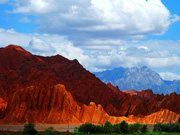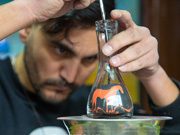

Hans Sues, chair of the Department of Paleobiology at the Smithsonian's National Museum of Natural History, holds up a tooth of a new dinosaur, Timurlengia euotica (L), in comparison to the tooth of a Tyrannosaurus rex (R), after a news conference in Washington D.C., the United States, March 14, 2016. Scientists said Monday they have discovered the fossilized remains of a new horse-sized dinosaur that revealed how Tyrannosaurus rex (T. rex) became one of Earth's top predators about 70 to 80 million years ago. (Xinhua/Yin Bogu)
WASHINGTON, March 14 -- Scientists said Monday they have discovered the fossilized remains of a new horse-sized dinosaur that revealed how Tyrannosaurus rex (T. rex) became one of Earth's top predators about 70 to 80 million years ago.
T. rex and its close relatives reached the top of their food chain at the end of the age of dinosaurs, after other groups of large meat-eating dinosaurs had gone extinct about 80 to 90 million years ago.
But little was known about how these fearsome giants evolved from a family of small-bodied dinosaurs known as tyrannosaurs, largely due to a gap in the family's fossil record between 100 and80 million years ago.
Now, the newly discovered species -- named Timurlengia euotica, which lived about 90 million years ago in today's Uzbekistan, seemed to help solve the mystery.
Timurlengia, named after the 14th-century Central Asian ruler Timurleng, is a tyrannosaur but not the ancestor of the T. rex.
"We had this huge gap in the fossil record, about a20-million-year gap," study author Hans Sues, chair of the Department of Paleobiology at the Smithsonian's National Museum of Natural History," told Xinhua.
"And this is an animal from the new tyrannosaurs from 90 million years ago in Central Asia, and it shows that at that point this animal had already evolved the complicated brain and advanced senses the T. Rex had. But it was in a horse sized animal, and so obviously the brain reorganization happened long before these animals became real giants."
Sues and a team of palaeontologists, led by Steve Brusatte at the University of Edinburgh, studied a collection of tyrannosaur fossils found between 1997 and 2006 in the Kyzylkum Desert, northern Uzbekistan, and discovered the new species.
They found the species' skull was much smaller than that of T. rex, indicating that it did not grow to the same enormous size. However, key features of Timurlengia's skull like large inner ear revealed that it had developed keen senses and cognitive abilities, including the ability to hear low-frequency sounds.
Timurlengia was about the size of a horse, and could weigh up to250kg. It had long legs and a skull studded with sharp teeth, and was likely a fast runner, researchers said.
The first tyrannosaurs lived around 170 million years ago and were only slightly larger than a human. However, by the late Cretaceous Period -- around 100 million years later -- tyrannosaurs had evolved into animals like T. rex and Albertosaurus, which could weigh more than seven tons.
The fact that the new species was still small some 80 million years after tyrannosaurs first appeared indicated that T. rex developed huge body sizes rapidly at the very end of the group's evolutionary history, they said.
"The ancestors of T. rex would have looked a whole lot like Timurlengia, a horse-sized hunter with a big brain and keen hearing that would put us to shame. Only after these ancestral tyrannosaurs evolved their clever brains and sharp senses did they grow into the colossal sizes of T. rex. Tyrannosaurs had to get smart before they got big," Brusatte said.
The study, published in the U.S. journal Proceedings of the National Academy of Sciences, was funded by the European Commission, National Science Foundation, National Geographic Society and the Russian Scientific Fund Project.
 |
Day|Week

 Beijing steps up security for 'two sessions'
Beijing steps up security for 'two sessions' Chongqing sniper’s new record: 13 holes on a rice grain
Chongqing sniper’s new record: 13 holes on a rice grain Women put on spring dresses in Hangzhou
Women put on spring dresses in Hangzhou UAVs at Unmanned Systems Exhibition & Conference in UAE
UAVs at Unmanned Systems Exhibition & Conference in UAE PLA's paratroopers conduct night training
PLA's paratroopers conduct night training Three new-type tank landing ships join the East China Sea Fleet
Three new-type tank landing ships join the East China Sea Fleet 3,492 reflector panels of China's mega telescope installed
3,492 reflector panels of China's mega telescope installed Stunning Kuche on the Silk Road
Stunning Kuche on the Silk Road Tunisian man creates art of sand in Hangzhou
Tunisian man creates art of sand in Hangzhou Goddess teacher shares fitness program online
Goddess teacher shares fitness program online